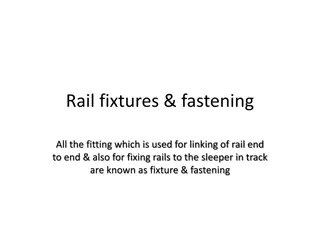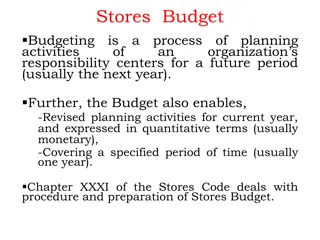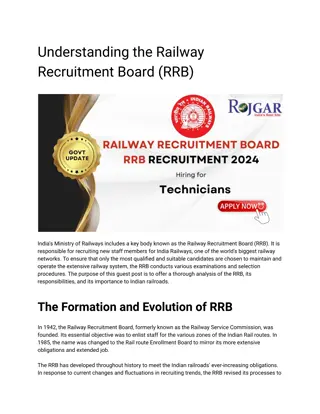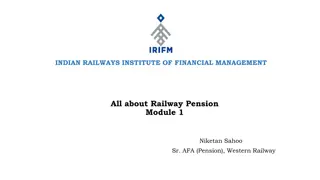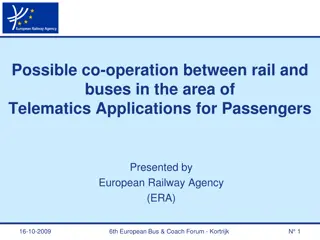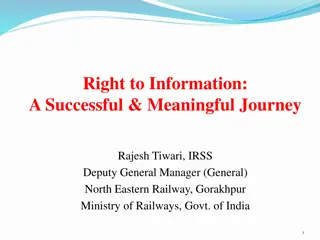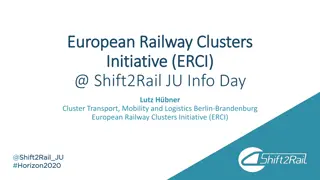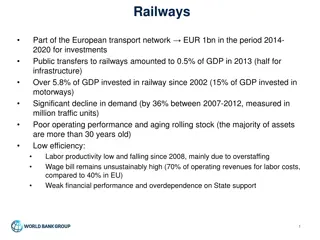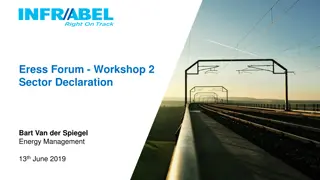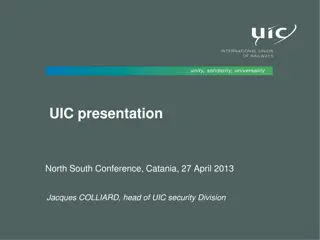Analyzing Security Resource Allocation in Railway Networks
Analyzing the best security resource allocation strategy in a railway network involving stations, lines, and potential threats like pickpocketing, fare evasion, and terrorism. Discusses the importance of predictive models, constraints, and optimal resource allocation to combat organized adversaries.
Download Presentation

Please find below an Image/Link to download the presentation.
The content on the website is provided AS IS for your information and personal use only. It may not be sold, licensed, or shared on other websites without obtaining consent from the author.If you encounter any issues during the download, it is possible that the publisher has removed the file from their server.
You are allowed to download the files provided on this website for personal or commercial use, subject to the condition that they are used lawfully. All files are the property of their respective owners.
The content on the website is provided AS IS for your information and personal use only. It may not be sold, licensed, or shared on other websites without obtaining consent from the author.
E N D
Presentation Transcript
From risk analysis to adversarial risk analysis Part VI. Adversarial risk analysis David R os, AXA-ICMAT Chair @ICMAT-CSIC and R. Academy DRI. USST
So far Conceptual framework in RA IDs as problem structuring tool Probabilities for modeling uncertainty Utilities for modeling preferences Expected utilities for optimal alternatives Computational framework for risk analysis Basic concepts for game theory (towards RA) This deck An introduction to Adversarial Risk Analysis DRI. USST 2
Which is the best security resource allocation in a railway network? Railway Network as stations, lines (&hotspots ) Threats: Pickpocketing, Fare evasion, Terrorism, Each element has a value For each element, each threat, a predictive model of acts Allocate security resources (constraints) For each cell predict the impact of resource allocation Optimal resource allocation DRI. USST
Which is the best security resource allocation in a railway network? Railway Network as stations, lines (&hotspots ) Threats: Pickpocketing, Fare evasion, Terrorism, Each element has a value For each element, each threat, a predictive model of acts Allocate security resources (constraints) For each cell predict the impact of resource allocation Optimal resource allocation NB1: Bad guys operate intelligent and organisedly!!! DRI. USST
Which is the best security resource allocation in a railway network? Railway Network as stations, lines (&hotspots ) Threats: Pickpocketing, Fare evasion, Terrorism, Each element has a value For each element, each threat, a predictive model of acts Allocate security resources (constraints) For each cell predict the impact of resource allocation Optimal resource allocation NB1: Bad guys operate intelligent and organisedly!!! NB2: Different bad guys uncoordinated DRI. USST
From RA to ARA DRI. USST
Motivation The World s (23) Biggest Problems (Lomborg) Arms proliferation Conflicts Corruption Terrorism Drugs Money laundering One of FP8 priorities (Secure Societies FCT, BD, DS) One of 8 research challenges in Spain DRI. USST
Motivation RA extended to include adversaries ready to increase our risks S-11, M-11 lead to large security investments globally, some of them criticised Many modelling efforts to efficiently allocate such resources Parnell et al (2008) NAS review Standard reliability/risk approaches not take into account intentionality Game theoretic approaches. Common knowledge assumption Decision analytic approaches. Forecasting the adversary action Merrick, Parnell (2011) review approaches commenting favourably on ARA DRI. USST
ARA A framework to manage risks from actions of intelligent adversaries Banks, Rios, DRI Adversarial Risk Analysis (2015) Taylor Francis One-sided prescriptive support Use a SEU model Treat the adversary s decision as uncertainties Method to predict adversary s actions We assume the adversary is a expected utility maximizer Model his decision problem Assess his probabilities and utilities Find his action of maximum expected utility (But other descriptive models are possible) Uncertainty in the Attacker s decision stems from our uncertainty about his probabilities and utilities but this leads to a hierarchy of nested decision problems (random, noninformative, level-k, heuristic, mirroring argument, ) vs (common knowledge) Kadane, Larkey (1982), Raiffa (1982, 2002) Lippman, McCardle (2012) Stahl and Wilson (1994, 1995) D. Wolpert (2012) Rothkopf (2007) DRI. USST
First Defender, afterwards Attacker Nash Solution, SPE: Standard DRI. USST Game Theory Analysis
Supporting the Defender Defender problem Defender s solution Modeling input: ?? DRI. USST
Supporting the Defender: The assessment problem Elicitation of Defender s view of Attacker problem Assume A is a EU maximizer D s beliefs about MC simulation where DRI. USST
Sequential D-A DRI. USST
Simultaneous games Decisions are made without knowing each other s decisions DRI. USST
Supporting the Defender Defender s decision analysis How to assess it ?? DRI. USST
Assessing Attacker's decision analysis as seen by the Defender DRI. USST
The assessment problem To predict Attacker s decision The Defender needs to solve Attacker s decision problem She needs to assess Her beliefs about probability distribution are modeled through a The assessment of D s analysis of A s analysis of D s problem requires deeper analysis It leads to an infinite regress thinking-about-what-the-other-is-thinking-about DRI. USST
Hierarchy of nested models Stop when the Defender has no more information about utilities and probabilities at some level of the recursive analysis. Level-k thinking DRI. USST
Opponent modeling Non strategic Nasheq Level-k Mirroreq Prospectmax Reconcile them through a mixture DRI. USST DRI, Banks, Rios (2015) RA
Piracy in Somalia Piracy and armed robbery incidents reported to the IMB Piracy Reporting Centre 2011 DRI. USST
The DefendAttackDefend model Two intelligent players Defender and Attacker Sequential moves First, Defender moves Afterwards, Attacker knowing Defender s move Afterwards, Defender again responding to attack DRI. USST
The Somali Pirates Case: Problem formulation Two players Defender: Ship owner Attacker: Pirates Defender first move Do nothing Private protection with an armed person Private protection with a team of two armed persons Go through the Cape of Good Hope avoiding the Somali coast Attacker s move Attack or not to attack the Defender s ship Defender response to an eventual kidnapping Do nothing Pay the ransom Ask the Navy for support to release the boat and crew DRI. USST
(nothing) S,P (pay) S = 1 (attack) (Navy) S (nothing) S = 0 A (no attack) (nothing) (pay) S = 1 (attack) (Navy) S (man) S = 0 A (no attack) (nothing) (pay) S = 1 (attack) (Navy) S (team) S = 0 A (no attack) DRI. USST (alternative route)
(nothing) Defender s decision analysis 15.16 (pay) S = 1 2.3 (attack) (Navy) S 4.28 0 0 (nothing) S = 0 A (no attack) (nothing) 17.25 (pay) S = 1 4.39 (attack) (Navy) 6.37 0.05 0.05 S (man) S = 0 A (no attack) (nothing) 19.39 (pay) S = 1 6.53 (attack) (Navy) 8.51 0.15 0.15 S (team) S = 0 A (no attack) DRI. USST (alternative route) 0.5
ARA: Cases Problem Defender Attacker Specificities Template ATC protection Airport authority Terrorist Single site D-> A Piracy Ship owner Pirates Single site D- >A - > D Metro Operator Pickpock Fare evasion Multisite Multiattack, Cascade D->A Urban security Police Mob Multisite spatial D->A->D Train DoT, DoD Terrorist Multisite network D->A->D Reliability Manufacturer Customer -- D->A SME IS Company Competitor Cyber, Integrated with RA D->A Oil rig cybercontrolled Oil company Sponsored hackers Cyber, Multiattack D->A->D UAV fight Country Country Multisite D->A->D CI Owner Terrorist Multistage General Cybersec res allocation+cybins IT Owner Hacker(s) Several decisions Random and targeted attacks D-A, D-A-D DRI. USST Social robots Robot User Sequential D->A
ARA templates DRI. USST
ARA templates DRI. USST
More general interactions DRI. USST
ARA vs GT Provide different solutions Dominance and ARA Iterated dominance and ARA Ficticious play and ARA Level-k and ARA GT, Sensitivity analysis, If sensitive, ARA. Different types of adversaries DRI. USST
Adversarial classification as a game C, classifier. A, adversary Two classes: + malicious; - innocent. C and A maximise expected utility under common knowledge conditions Finding Nash equilibria extremely complex Dalvi et al (2004) propose a scheme Utility sensitive Naive Bayes Forward myopic approach under strong common knowledge DRI. USST
Adversarial problems DRI. USST
Problem An agent makes decisions in a finite set Has sensors providing information around it It relates with a user which makes decisions They re both within an environment which evolves (under the control of the user) DRI. USST
Basic framework Deducir estado emocional Actualizar modelo predicci n Inferir acci n bt Elegir acci n at+1 Interpretar estado et Leer sensores st Actualizar reloj DRI. USST
Basic framework (Si Liu) Several bots: Support each of the bots, treat the other bots as users (selfish 1). ARA Allow them to communicate, compute nash equilibria (selfish 2) If they communicate, from selfish to cooperative. ARA Emotions impacting degree of cooperativeness DRI. USST
Other themes Differential games Multiagent reinforcement learning Competition and cooperation Partial information Cybersecurity and cyberinsurance Efficient computational schemes Computational environment Fake news Malware detection Attacker models Generative adversarial networks Generic approach: point estimation, interval estimation, Multiple attackers, Multiple defenders DRI. USST
Wrapping up Conceptual framework in RA IDs as problem structuring tool Probabilities for modeling uncertainty Utilities for modeling preferences Expected utilities for optimal alternatives Computational framework for risk analysis Basic concepts for game theory (towards RA) An introduction to Adversarial Risk Analysis Questions david.rios@icmat.es Skype: david.rios.insua DRI. USST 37
david.rios@icmat.es PhD opportunities https://www.icmat.es/job- opportunities/inphinit_la-caixa/ DRI. USST







